(10 min read) While Rosslyn Chapel — number 49 in my countdown of the Fifty Greatest Works of Gothic — is the most contestable of my choices, it allows me to discuss chantry chapels, which are a fascinating bit of medieval culture, and conspiracy theories, which are increasingly important in the contemporary world.
(For more about this series, see the introduction and the countdown.)
Common Name: Rosslyn Chapel
Official Name: The Collegiate Chapel of Saint Matthew
Location: Roslin, Scotland
Primary Dates of Gothic Construction: c1450-c1500(?)
Why It’s Great
Maybe it’s not. But Rosslyn Chapel is definitely a unique little jewel of highly decorated Gothic, and it illustrates some interesting aspects of medieval and contemporary culture regarding the funding for Gothic’s original construction and its contemporary maintenance.
Why It Matters: History and Context
I wrote in the introduction to this series that the lower-ranked buildings would be the most subjective and contestable, as would be the case for any such survey. And Rosslyn Chapel is likely the most contestable choice I am making.
In part I have chosen Rosslyn Chapel because it is Scottish and I want to have well-rounded regional representation in my set. That is also why I chose Matthias Church as #50 (I wanted to include something from Hungary). And, as you will eventually see, the buildings that I ranked as 48 and 45 were also chosen — at least in part — to be representatives of their countries.
While Scotland has several more obvious contenders for this list — Edinburgh and Glasgow Cathedrals, for example — I chose Rosslyn for its distinctiveness and its prominence in modern popular culture. Its highly decorated Gothic style and mysterious carvings set it apart architecturally, while its ties to conspiracy theories and fictional narratives make it uniquely relevant to contemporary culture.
The chapel also provides an opportunity to discuss medieval chantry chapels — a fascinating element of Gothic religious culture — and the role of modern tourism in preserving historic sites. Thanks to its appearance in The Da Vinci Code and the myths surrounding it, Rosslyn has become a global destination, blending the worlds of history, fiction, and pseudo-history in a way few other Gothic buildings can claim.
So take the above as a “mea culpa” of sorts to any Gothic architecture experts out there who have an issue with the inclusion of Rosslyn Chapel in this list. This is not an uncritical endorsement of Rosslyn. Its inclusion here is as much about the conversation it can stimulate — which I said was one of my purposes in curating this list — as it is about the building itself.
Chantry Chapels & The Founding of Rosslyn Chapel
Rosslyn Chapel was founded in 1446 by William Sinclair, 1st Earl of Caithness and member of the influential Scottish-Norman Sinclair family. While technically a collegiate church (ie, independent of any bishop or abbey), it was founded in order to perform a daily Liturgy of the Hours and daily Masses on behalf of Sinclair family members.
The Liturgy of the Hours (essentially a daily cycle of prayers and hymns performed on behalf of the broader community) was a critical service performed by the clergy in the medieval world, and played an important role in the funding and programming for medieval religious architecture. In addition, aristocratic funding for medieval religious architecture included the saying of regular Masses on behalf of the founders (and often their families or local communities) after they died. The performance of these Masses was intended to increase the odds of acceptance into Heaven as well as shorten one’s time in Purgatory.
Beginning in the later 14th century, the idea of funding smaller chapels within churches for the performance of these Masses became widespread; these were known as chantry chapels. While most chantry chapels were located within churches as side chapels, a few were built as standalone buildings. And despite being technically a collegiate church, Rosslyn Chapel was essentially an exceptional example of a chantry chapel, performing regular Masses for the souls of the Sinclairs.
The Scottish Reformation & Rosslyn’s Dissolution
The Scottish Reformation brought an abrupt end to Catholic services in Rosslyn Chapel. In 1560, the Reformation Parliament outlawed the Mass and other Catholic services, confiscated the assets associated with Catholic institutions, and repurposed or abandoned many buildings. (This was in many ways the same process as happened in England during the “Dissolution of the Monasteries” from 1536 to 1541.)
And so the Liturgy of the Hours and the Masses for the Sinclairs ended in Rosslyn Chapel in 1560, with the Reformation Parliament's decision to outlaw the Mass. In addition, in 1592, the chapel's altars were destroyed during further anti-Catholic measures. The place was eventually abandoned and by the 19th century it had fallen into disrepair and was largely in ruins (along with scores of other churches and abbeys throughout Great Britain, many of which are still impressive sights in their ruined states today.)
Conspiracy Theories & The Renaissance of Rosslyn
In the mid-19th century, as part of the broader Gothic revival movement sweeping across Europe, Rosslyn Chapel was revived. The chapel was restored and in 1862 rededicated under the Scottish Episcopal Church. For some 140 years it functioned as a small, relatively obscure place for local worship, and was maintained at modest levels.
Then, in 2003, came Dan Brown’s book “The Da Vinci Code,” which features Rosslyn Chapel in some scenes (so I am told, I have neither read the book nor seen the movies). The book became an instant bestseller and three years later was made into a movie three years later, with several scenes filmed in Rosslyn Chapel.
Although the book and subsequent film fictionalized much of the chapel's history, their popularity drew attention to earlier conspiracy theories, notably those from the pseudo-historical The Holy Blood and the Holy Grail (1982). These theories claim that because of the Sinclair family’s ties to the Knights Templar and Freemasonry (which is true), might house the legendary Holy Grail (which is silly.)
Connections to the Templars and Freemasons are the kind of things that drive conspiracy-minded people nuts. Combining that with the often obscure and enigmatic iconography you see in Gothic decoration — which could be intrepreted as having secret meanings and which Rosslyn has in abundance — makes the chapel a gold mine for hatching poorly thought out theories about secret cabals and hidden messages.
Brown’s book made these notions mainstream and led to a massive increase in tourism and eventually huge grants for more complete restorations and even the building of a Visitor Center, which opened in 2011.
A massive influx of tourists, properly handled, can be a great boon for historic sites, and there is no reason to bemoan it — it allows for proper restoration and maintenance of an historic landmark which would otherwise probably not happen. Likewise, it is not uncommon for an historic site that was featured in a movie to become super popular. Sites where Harry Potter was filmed — like the cloisters of Glouster Cathedral, for example — are often filled with kids (and kids at heart) getting their photos taken in them.
However, what is unique about the visitors to Rosslyn Chapel and which speaks more directly to our cultural moment — specifically the disintegration of shared narratives and rise of conspiracy-minded thinking — is that many of them are unable to distinguish fact from fiction and believe the easily debunked theories in “The Holy Blood and the Holy Grail” and related works.
While Dan Brown’s novels are clearly intended as fiction, the connections between its themes and a pseudo-history that purports a worldwide conspiracy lead certain people to either gullibly or willfully accept laughable ideas as true. Much like the LARPing QAnon followers who choose to live in a simplified fantasy world rather than accept the complexity of the world or the obvious moral failings of their messianic hero, a significant percentage of visitors come to Rosslyn Chapel to reinforce their false ideas about the world.
And that is something that the current managers of Rosslyn can be (and have been) faulted for — encouraging unhistorical and clearly incorrect ideas in order to “cash in” and boost their visitor count.
In addition, I personally fault the current mangers of the building for trying to further “cash in” on the buildings popularity and force the sale of their monographs by forbidding interior photography. Because, as you will see, this impacted my ability to document the building and provide you with as good a virtual photo tour as I would have liked.
Photo Tour
Rosslyn Chapel is accessed through a Visitor Center, which I neglected to photograph. But after passing through it you are faced with the north side of the chapel (figure 8).
The exterior is well worth walking around and looking at closely. Since it is a small building, you can get a closer look at the gargoyles and carvings than in most churches and cathedrals (figure 5 above and 9-12 immediately below).
A lot of the carvings are quite worn and presumably from the original 14th century construction, but restoration efforts have replaced some as well. Figure 13 shows two of four labeled plinths showing the carving process, as well as the finished product installed.
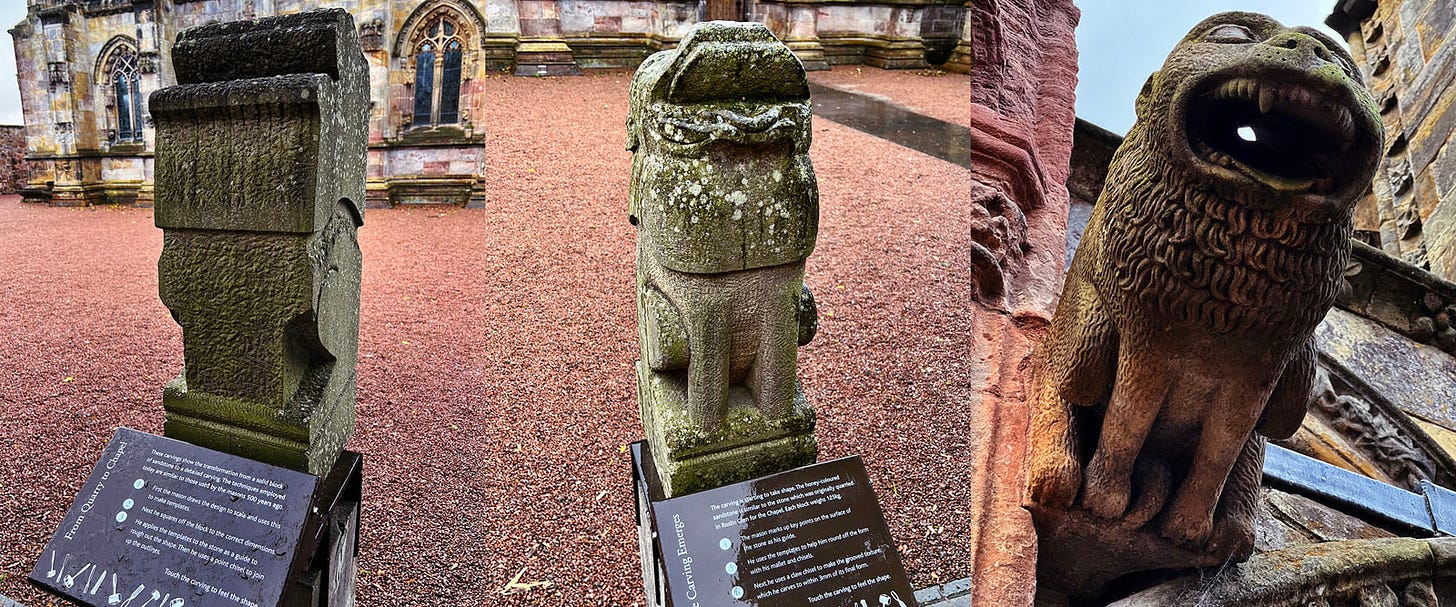
The main entrance to the chapel is on the west side (figure 14).
Photography is not permitted on the inside, but I managed to sneakily take over a dozen photos, some which I share below. First the main building, which consists of a chancel (being a chapel there is no nave), with side aisles and Lady Chapel behind the altar:


On the south side of the building, down a flight of stairs, there is a sacristy:
The sacristy also contains shelves with a number of finds from around the chapel (I presume, there were no labels anywhere in this area). The most interesting piece is the tombstone in figure 21, which looks to me like a number from the 17th or 18th centuries with some enigmatic “memento more”-style iconography that could easily fuel the imagination of a conspiracy-minded person.
Visiting Advice & Conclusion
My Visit Date: 6 October 2022
Rosslyn Chapel is located in the town of Roslin, which is about 7 miles (11km) south of Edinburgh. Public transport — which I rode — is easy, as there is a single bus line that will take you within a 5-min walk of the chapel. But the Visitor Center also has parking, so driving is an easy option as well. If you are visiting Edinburgh (which is a wonderful city worth several days), visiting here would take up half a day including the public transport.
Entrance to the site requires a ticket and is through the Visitor Center, which provides a little context and history of the place. As I mentioned above, photography is not permitted and there were multiple docents in the interior watching when I was there. But, as you can tell from the above, a little patience and willingness to be a scofflaw will permit you to grab a few shots if you so desire.
Dan Brown really made this place popular, so it can get crowded. If you want to ensure a relatively peaceful visit I would suggest arriving when they open — the building is small, so it doesn’t take many people to make it feel crowded.






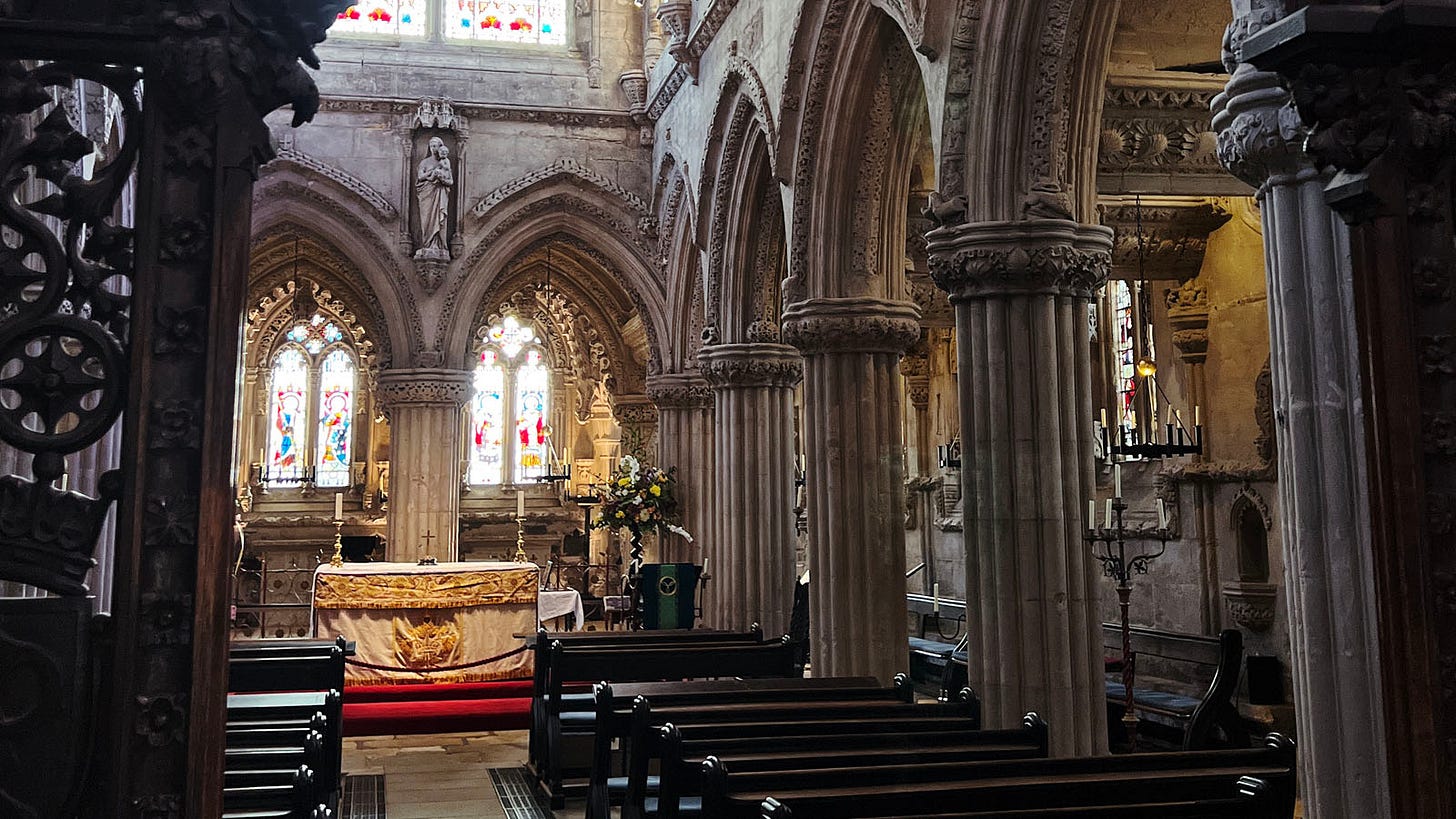
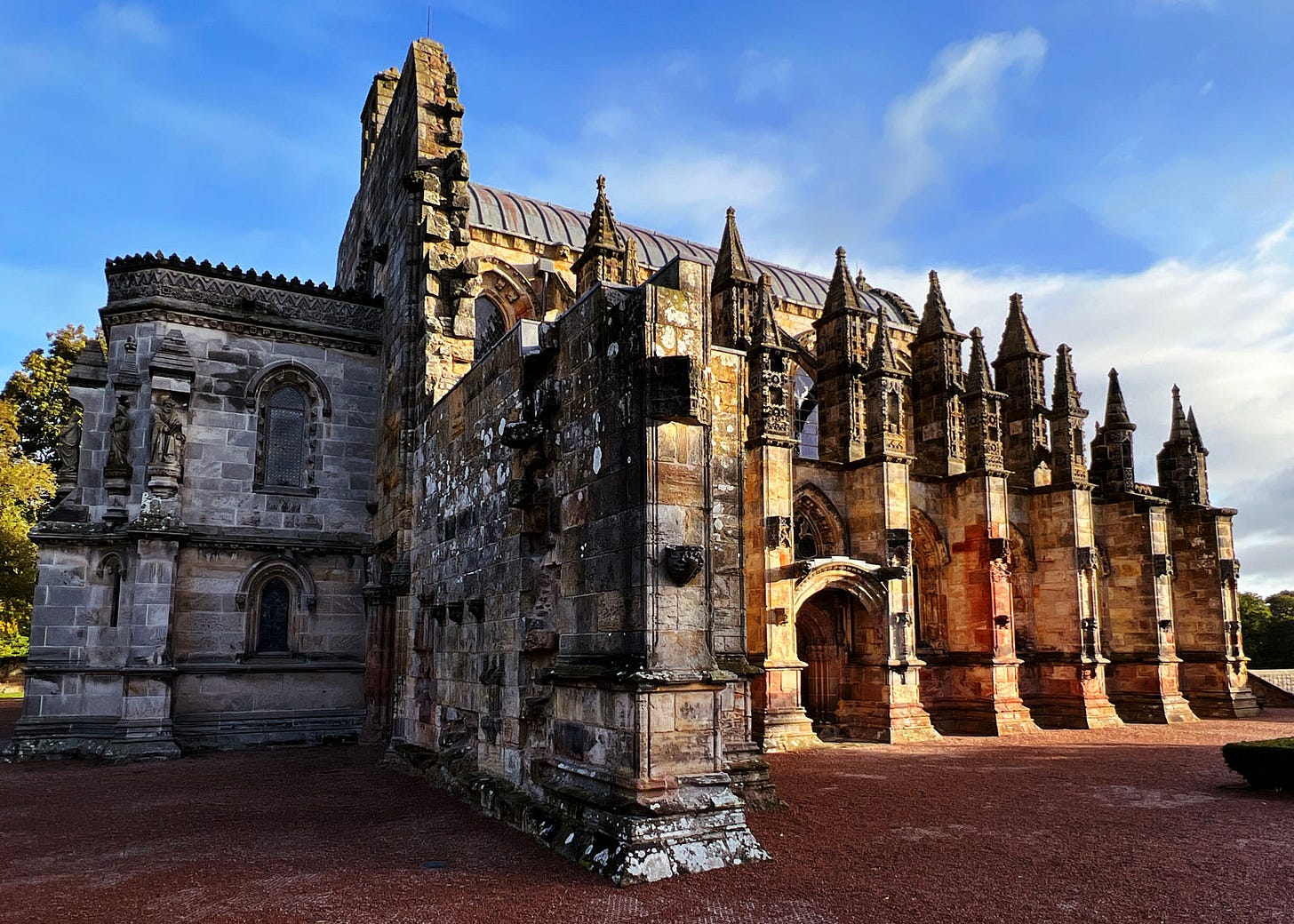
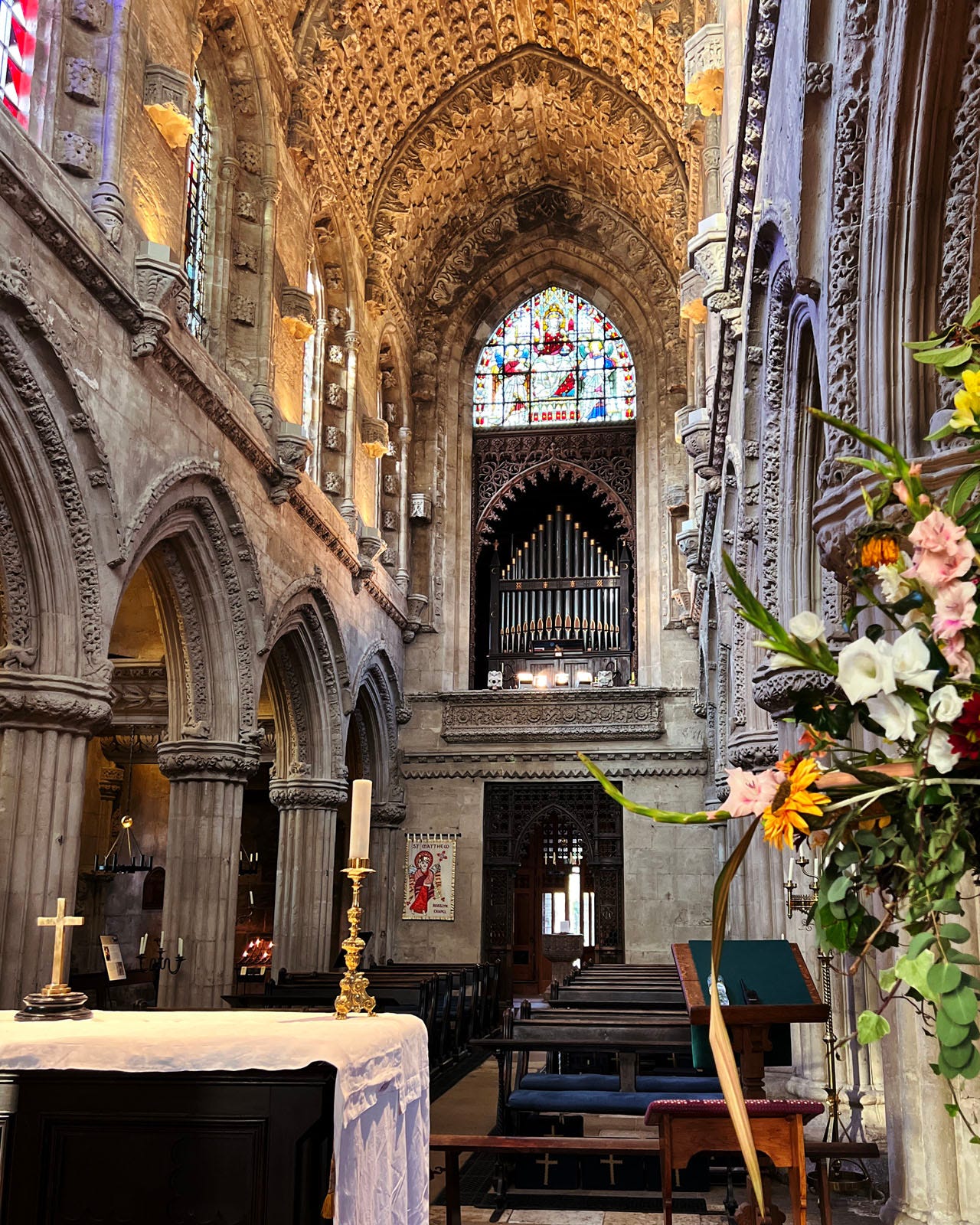
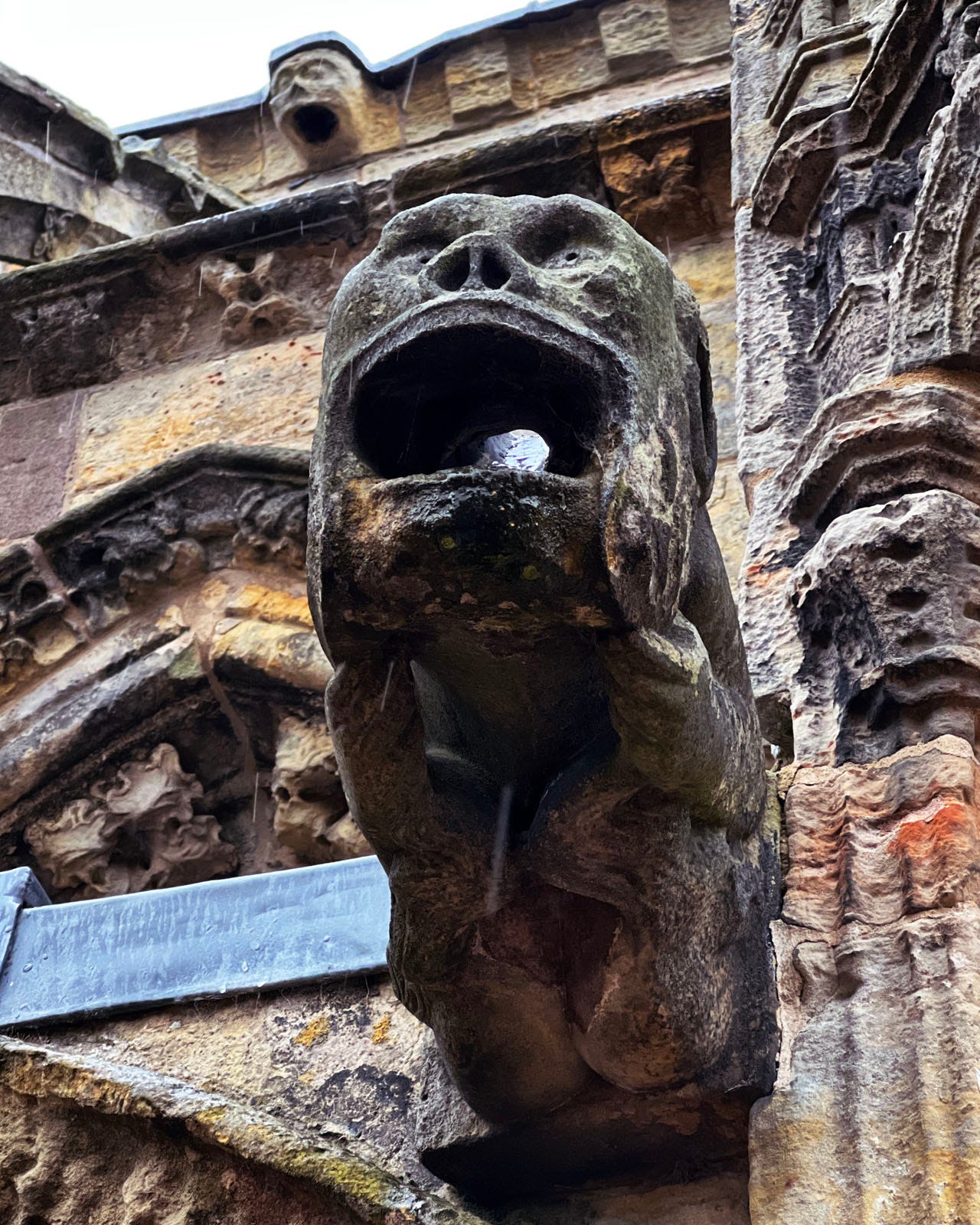

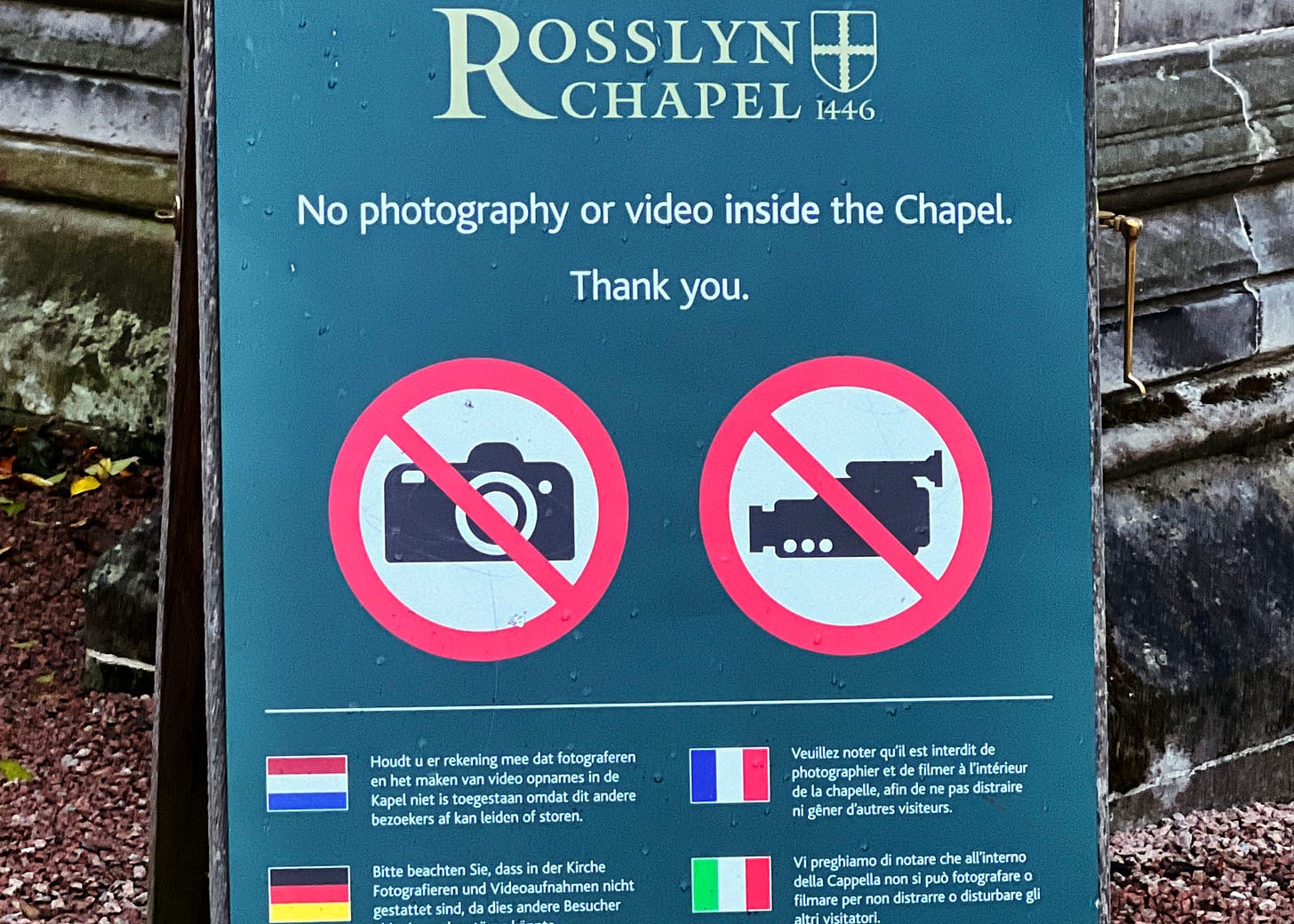
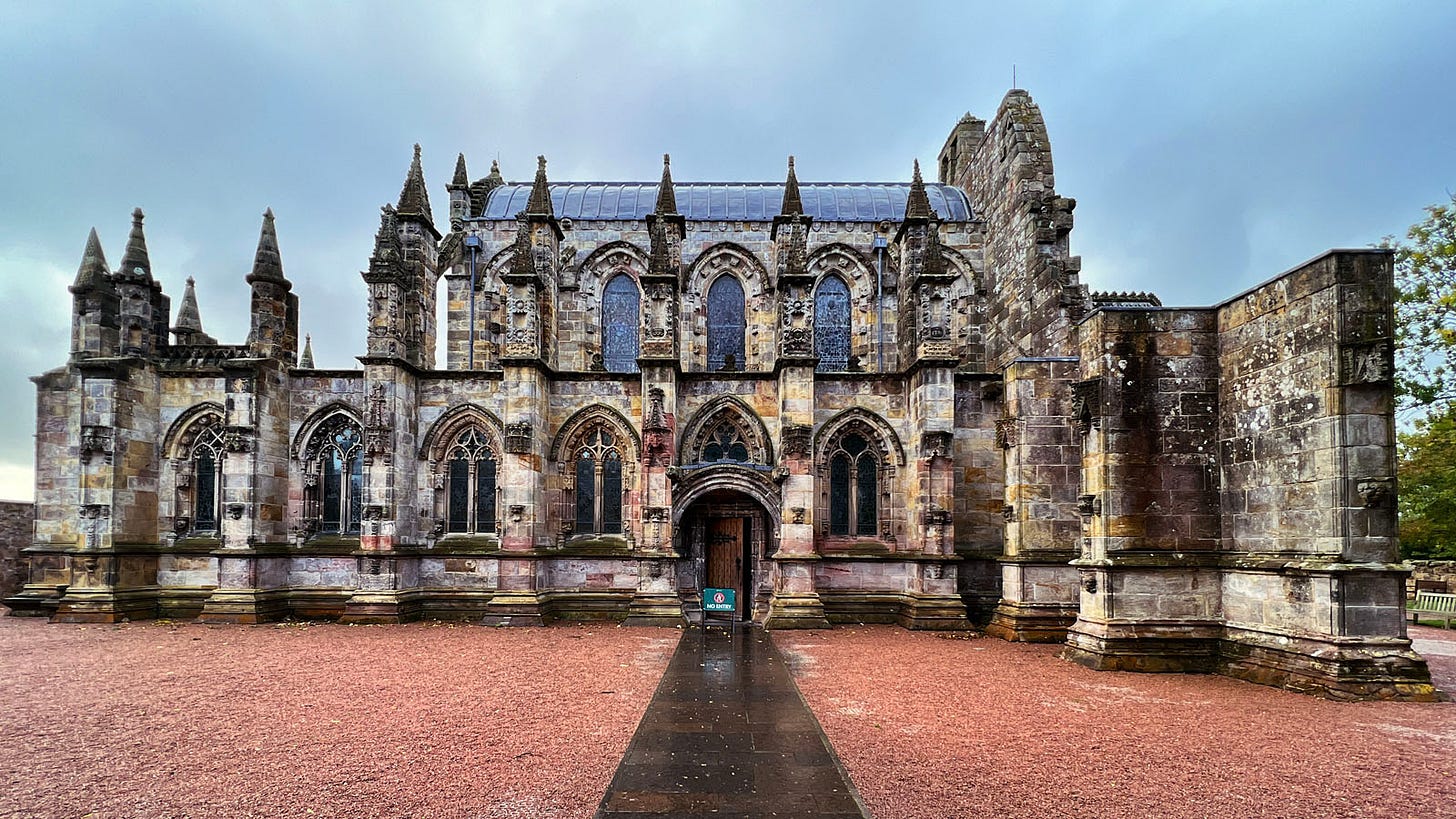
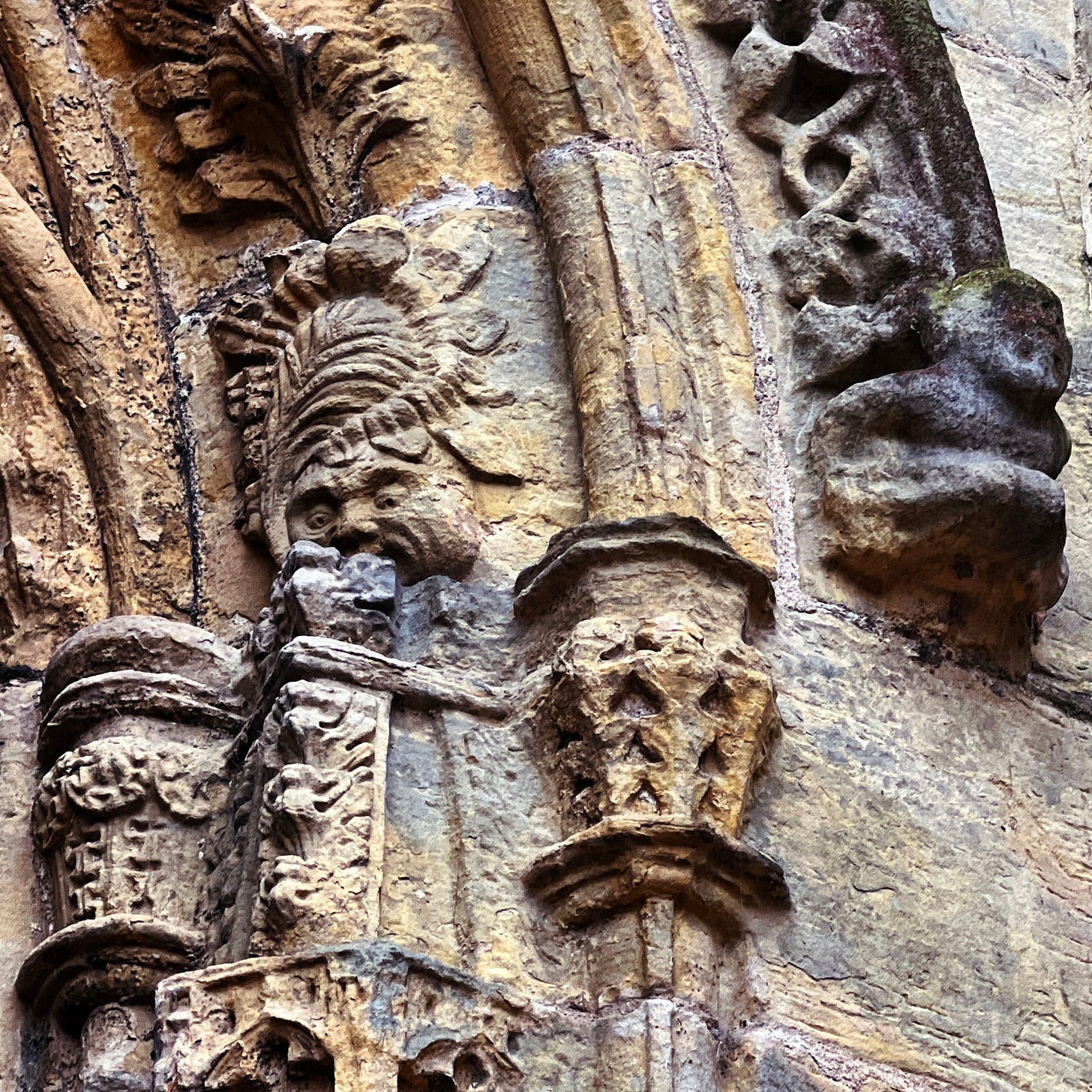


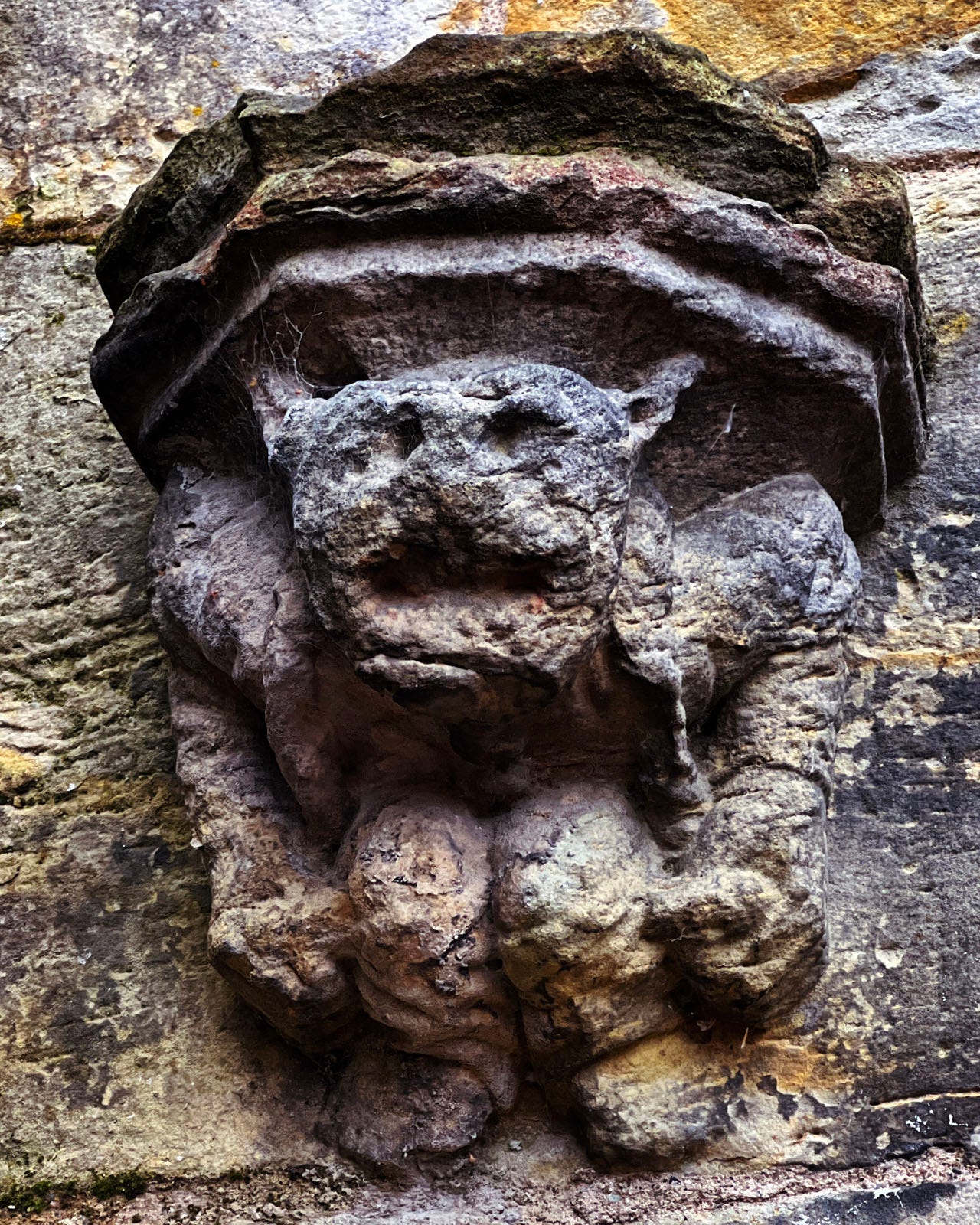


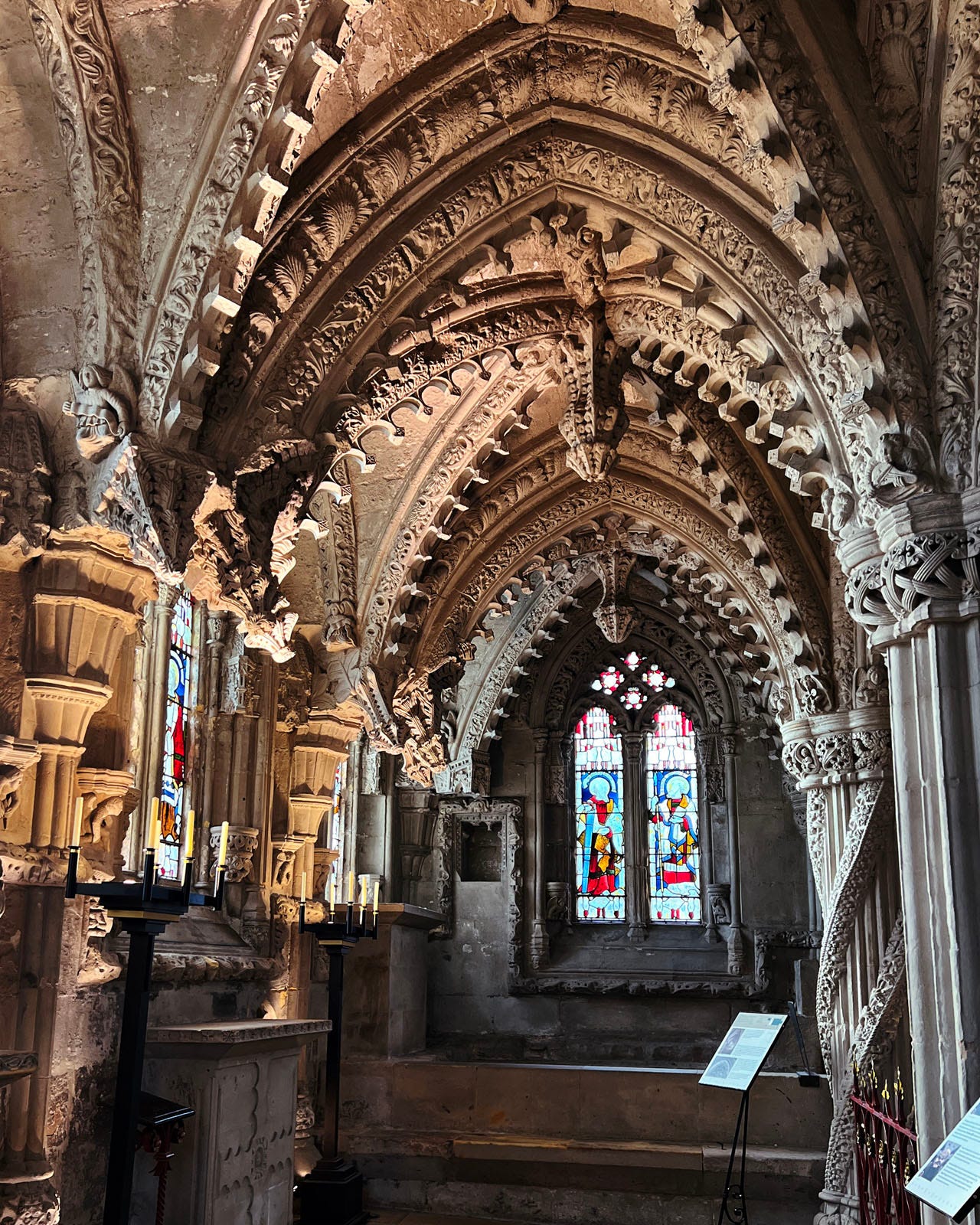



“Cute little worn demon” 🤣
Hi Ben, what an extraordinary exterior! Really looks like it was going to be added to with a larger building along side.
Thank you for also being a Scofflaw. I have seen the film and it portrays the church as more of a parish church with a gang of very tough and grim guardians ready to deal with unwanted visitors in ruthless manner - rather like your Docents but with the added threat of grievous bodily harm thrown in. Though that screen shot shows only a glimpse of that Apprentice pillar.
I think the sheer beauty of the vaulting and that magnificent Apprentice pillar are well worth its inclusion at 49. Great photos.